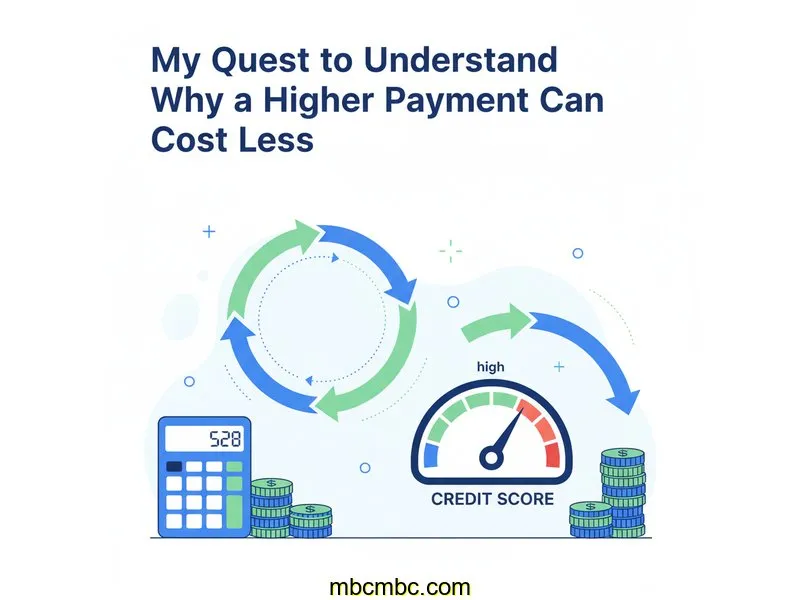
Auto Loan Calculator
Calculate payments over the life of your Loan
Home Blog Privacy Terms About Contact
Calculate payments over the life of your Loan
Home Blog Privacy Terms About ContactPublished on October 14, 2025

My journey into the world of loan calculations started with a simple, yet confusing, conversation. A friend was talking about their recent loan and mentioned choosing a shorter repayment period, even though it meant a higher monthly payment. I remember thinking, "Why would anyone choose to pay more each month if they could pay less?" It seemed completely counterintuitive to me.
This little puzzle stuck with me. My entire understanding was based on a simple premise: a lower monthly bill is better. But what if I was missing something? What if the math told a different story? This question wasn't about making a financial decision; it was about pure curiosity. I needed to understand the mechanics behind the numbers. How could paying more, sooner, possibly result in a better outcome?
I decided to dive in, armed with a few online loan calculators. My goal was simple: to figure out the relationship between the loan term (the length of the loan) and the total cost. I wanted to see the numbers for myself and understand why my friend made that choice. I wasn't looking for advice, just for clarity. This is my journey of untangling that specific piece of financial math, and it's all about understanding how the calculations work, not giving financial advice.
My initial attempts were clumsy. I found a basic calculator and plugged in some numbers. I focused on a single field: the "Estimated Monthly Payment." I kept adjusting the loan term, watching that number go up and down, feeling like I was confirming my original belief. A longer term always meant a smaller, more manageable-looking number. But a nagging feeling told me I was only seeing a fraction of the picture.
My confusion peaked when I decided to create a hypothetical scenario to test my theory. I imagined a personal loan for a home improvement project, something tangible. I settled on an amount of $18,450 at a fixed interest rate of 7.8%. My goal was to compare a 5-year term against a 4-year term.
I went to the first online calculator I found and entered the details for the 5-year (60-month) term. The calculator spat out a monthly payment of approximately $374.01. "Okay," I thought, "that's my baseline." It seemed reasonable enough. My brain immediately categorized this as the "cheaper" option because the monthly figure was lower.
Next, I changed only one variable: the loan term. I reduced it to 4 years (48 months) and clicked "Calculate." The new monthly payment was $446.73. My initial reaction was one of validation. "See? It's over $72 more per month! The 5-year plan is obviously the better deal." I was so focused on that single output that I almost closed the browser, satisfied with my simple conclusion.
But that's when the frustration set in. It still didn't explain my friend's logic. Why would they willingly pay $72 more every single month? It felt like I was staring at a math problem where I only had one piece of the solution. I was comparing apples and oranges without even realizing it. I was comparing a single payment amount, completely ignoring the fact that one scenario involved making 60 of those payments, while the other involved only 48. My mistake was fundamental: I was looking at the monthly cost, not the lifetime cost of the loan. This realization was the turning point; I knew my calculation method was flawed and I had to dig deeper.
My breakthrough came when I stumbled upon a more detailed loan calculator. This one had more fields and, crucially, a button that said "Show Amortization Schedule." Alongside the monthly payment, it displayed two other numbers that I had previously ignored: "Total Principal Paid" and "Total Interest Paid." This was the missing piece of the puzzle.
Driven by my newfound curiosity, I ran my scenario again. First, the 5-year loan. I entered $18,450 at 7.8% for 60 months. Yes, the monthly payment was $374.01. But then I looked at the other fields. The "Total Interest Paid" was a staggering $3,990.60. This was the true cost of borrowing the money over five years.
My heart pounded a little faster. I quickly changed the term to 4 years (48 months). The monthly payment popped up again: $446.73. But this time, I ignored it and went straight to the total interest field. The number I saw was $2,993.04. I did the math in my head instantly. That was nearly a thousand dollars less in interest! Suddenly, it all clicked. The higher monthly payment wasn't a penalty; it was the result of paying the loan off faster, which gave the interest less time to accumulate.
The core concept I had missed was that interest is calculated on the remaining balance. With a longer loan term, the principal balance decreases more slowly. This means that for a greater number of months, interest is being calculated on a larger outstanding amount. It's a simple but powerful dynamic. Each of the 60 payments for the 5-year loan contains a portion of interest, while the 4-year loan only has 48 payments where interest can be charged.
This calculator field became my new North Star for understanding loan costs. It strips away the confusion of monthly payments and different timeframes and provides a single, comparable number. It directly answers the question: "How much am I paying for the service of borrowing this money?" Seeing the nearly $1,000 difference between the two scenarios was the most powerful lesson of my entire exploration.
To make sure this wasn't a fluke, I started playing with the calculator relentlessly. What if the loan was for $12,000? What if the rate was 5.5%? What about a 3-year term versus a 5-year term? Every single time, the pattern held true. The shorter term always had a higher monthly payment but a significantly lower total interest cost. I was no longer just looking at numbers; I was understanding the story they were telling about time and money.

This whole experience was incredibly eye-opening. It wasn't about deciding which loan was "better," but about learning how to accurately compare them from a mathematical standpoint. Here are the key lessons about calculation literacy that I took away from this journey.
During my deep dive, a few questions kept popping up. Here are some of the things I had to figure out, framed in a way that I hope helps others understand the mechanics.
It's all about time. Interest is calculated on your outstanding loan balance periodically (usually monthly). With a shorter term, you are forced to pay down the principal balance much faster. Because the balance shrinks more quickly, there is less money for the interest to be calculated on over the life of the loan. You are essentially giving the interest less time and a smaller balance to work against.
From my learning journey, if the loan amount and interest rate are the same, the "Total Interest Paid" field is the most direct way to compare the cost. It shows you the pure cost of borrowing. If the rates or amounts are different, looking at both the Total Interest Paid and the Annual Percentage Rate (APR), which includes fees, can give you a more complete picture of the overall cost.
This one is surprisingly simple, yet I missed it at first. You just multiply your monthly payment by the total number of payments (the loan term in months). For my example: $374.01/month × 60 months = $22,440.60. This simple multiplication reveals the total cash you'll pay over the entire loan term.
Yes, and this is where an "amortization schedule" is an amazing educational tool. Most good online calculators can generate one. It's a detailed table showing every single payment you'll make, breaking down how much of it goes toward principal and how much goes toward interest. It's fascinating to watch the interest portion shrink and the principal portion grow with each payment.
My biggest takeaway from this entire process is that the most intuitive answer isn't always the right one when it comes to math. I started out completely convinced that a lower monthly payment was the only thing that mattered. My journey taught me that looking at the full picture, especially the total interest paid over the entire loan term, reveals the true story.
It was empowering to move from confusion to clarity, all by playing with some online tools and asking "why?" I'd encourage anyone who feels intimidated by these numbers to do the same. Don't focus on making a decision; focus on understanding the mechanics. Change one variable at a time and see what happens. You might be surprised by the connections you find.
For me, the goal was never to find the "best" loan, but to understand the language of loans. And realizing that a higher monthly payment could actually mean paying less in the long run was a powerful lesson in looking beyond the surface. It’s a perfect example of how financial literacy is really just about understanding the math that shapes our world.
This article is about understanding calculations and using tools. For financial decisions, always consult a qualified financial professional.
Disclaimer: This article documents my personal journey learning about loan calculations and how to use financial calculators. This is educational content about understanding math and using tools—not financial advice. Actual loan terms, rates, and costs vary based on individual circumstances, creditworthiness, and lender policies. Calculator results are estimates for educational purposes. Always verify calculations with your lender and consult a qualified financial advisor before making any financial decisions.
